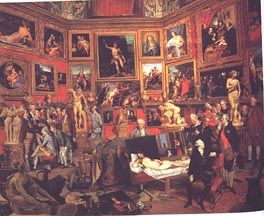

Zoffany's The Tribune of the Uffizi epitomises the eighteenth century idea of the connoisseur and the idea of the masterpiece. These English gentlemen have come to Italy expressly to study these monuments of art extending from Antiquity to their present world. Their reverence for these reflects an assumption that these works have transhistorical value. These great works are part of a body of works that were understood to form a canon of art. The selection of works extending back to Greek and even Egyptian antiquity calls to attention the authority of the Western cultural tradition.
The authority of this Western Tradition and the reverence for a body of great works or masterpieces that form a canon that exemplifies this tradition have become institutionalized in our museums, concert halls, libraries, publishing houses, university curricula. As Griselda Pollock has recently written (Differencing the Canon, p. 4): 'We know these canons --Renaissance, modernist, etc. through what gets hung in art galleries, played in concerts, published and taught as literature or art history in universities and schools, gets put on the curriculum as the standard and necessary topics for study at all levels of the educating --acculturating, assimilating-- process.
The English gentlemen's appreciation of the works displayed in the Tribuna is a token of their social and cultural prestige. In a vicarious way in their appreciation of the works they identify with the artists and patrons of the works and they understand themselves as owners of the works.
Left: detail of the Zoffany painting; Right: "The Medici Venus", copy of an original from the 3rd-2nd c. B.C.
Left: Detail of the Zoffany painting; Right: Titian's Venus of Urbino, c. 1538.
Not insignificantly the two most prominent works that the English gentlemen are admiring are two major examples of the nude female in western art: the Greek Hellenistic Medici Venus and Titian's Venus of Urbino. The gentlemen become discriminators of female beauty at the same time of artistic beauty. Their appreciation of these images makes them vicarious owners of not only the painting but also of the women depicted. The focus on these works also highlights the idea of the authority of the Western tradition extending back to the Classical period.
Like any re-presentation, Art History is contingent on particular subject positions. Absolute objectivity is a myth. All interpretations are partial and contingent. The accompanying texts were selected to represent the typical discourse found in traditional Art History textbooks. The latter part of this handout focuses on images of the female nude since the Renaissance. The discussions pertaining to Michelangelo's Creation of Adam are intended to present a contrast. We frequently assume that what is presented in a textbook represents the authority and objective standards of the discipline. Identify the priorities and assumptions evident in these texts. Read these texts "against the grain": what is overlooked?
Frederick Hartt, History of Italian Renaissance Art
, pp. 499-500:
Discussion of Michelangelo's Creation of Adam from the
Sistine Ceiling.
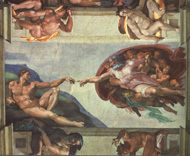
Of all the images that crowd the immense complex of the ceiling, the Creation of Adam is the one that has most deeply impressed posterity. Here we are given a single, overwhelming vision of the sublimity of God and the potential nobility of man, unprecedented and unrivaled in the entire history of visual art. Borne aloft in his wide-floating mantle bursting with the forms of wingless angels, the Lord moves before us, his calm gaze accompanying and reinforcing the movement of his mighty arm. He extends his forefinger, about to touch that of Adam, whose name means "Earth," and who reclines on the barren coast of earth, barely able as yet to lift his hand. The divine form is convex, explosive, paternal; the human is concave, receptive, and conspicuously impotent. All the pomp and splendor of customary depictions of the Almighty have vanished. The Lord is garbed only in a short tunic, which reveals the power of his body and limbs. Even Michelangelo's precise depiction of muscles, veins, wrinkles, fingernails, and gray hair does not reduce the universality of this celestial apparition, which radiates a power so immense as to seem a fitting embodiment of such a modern idea as cosmic energy. Love and longing stream from the silent face of Adam toward the Omnipotent, who is about to give him life and strength. In the breadth and nobility of the proportions, in the pulsation of the forms and the flow of their contours, above all in the intensity of feeling that moves through every plane, Adam is one of the most beautiful human figures ever imagined. A century of Early Renaissance research into the nature and possibilities of human anatomy seems in retrospect to lead to this single, unrecapturable moment, in which all the pride of pagan antiquity in the glory of the body, all the yearning of Christianity for the spirit have reached a mysterious and perfect harmony.
excerpts from Frederick Hartt, Art, 3rd ed, 1989
p. 615: Michelangelo's vision of a new and grander humanity
reaches its supreme embodiment in the Creation of Adam. Instead of standing
on earth as in all earlier creation scenes, the Lord floats through the heavens
and is enveloped in the violet mantle he wears in all the scenes in which he
appears. It is noted here for the first time that this violet color conforms
to that required for the vestments of the clergy during Advent and Lent, the
penitential periods before the coming of Christ at Christmas and his resurrection
at Easter. The Lord is borne aloft by wingless angels; with only a single youthful
exception, all of Michelangelo's angels are wingless, as if he could not tolerate
violation/ p. 615 of the beauty of the human body by an attachment from any
other form of life. Michelangelo's Creator for the first time makes believable
the concept of omnipotence. A dynamo of creative energy, God stretches forth
his hand, about to touch with his finger the extended finger of Adam. It was
shown by the late Charles Seymour that this image of the creative finger derives
from the famous medieval hymn "Veni Creator Spiritus" ("Come,
Creator Spirit") sung at Pentecost, the festival of the Descent of the
Holy Spirit, but also at conclaves in the Sistine Chapel, before the afternoon
scrutiny for the election of a new pope. In this hymn the "finger of the
paternal right hand" is invoked to bring speech to our lips, light to our
senses, love to our hearts, and strength to our bodies. Adam reclines on the
barren ground below, longing for the life and love about to be instilled by
this finger. As we have seen in the discussion of Jacopo della Quercia, Adam
means "Earth," and the figure is shown not as in Jacopo's relief,
merely astonished at the appearance of the Lord, but ready to be charged with
the energy that will lift him from the dust and make of him a "living soul"
(Genesis 2:7).
Adam's body is probably the most nearly perfect Michelangelo ever created, a structure embodying all the beauty of Classical antiquity and all the spirituality of Christianity. As in all High Renaissance compositions, the action in this one --based on the mirroring of the convex curve of the fecundating Creator in the concave curve of the receptive creature-- will vanish in seconds, and yet it is preserved forever....
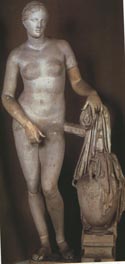
|
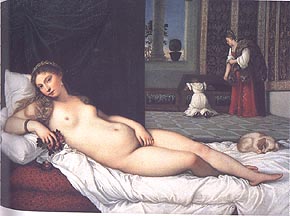
|
|
|
|
Helen Gardner, Art Through
the Ages, pp. 647-648: As Praxiteles brought the motif of the feminine nude
into ancient Greek art, so Giorgione and Titian re-create it for the art of
the modern West. In 1538, at the height of his powers, Titian painted for the
Duke of Urbino the Venus of
Urbino which gives us the compositional essentials for the representation
of a theme that will be popular for centuries. His version, based on an earlier
and pioneering one painted by Giorgione, was to become official for paintings
of the reclining nude, no matter how many variations would ensue. Venus reclines
on a gentle slope made by her luxurious, pillowed couch, the linear play of
the draperies contrasting with the sleek, continuous volume of her body. At
her feet is a pendant (balancing) figure --in this case, a slumbering lapdog.
Behind her, a simple drape serves both to place her figure emphatically in the
foreground and to press a vista into the background at the right half of the
picture.... All of the resources of pictorial representation are in Titian's
hands, and he uses them here to create original and exquisite effects.
Deep Venetian reds set off against the pale, neutral whites
of the linen and the warm ivory-gold of the flesh are echoed in the red tones
of the matron's skirt, the muted reds of the tapestries, and the neutral whites
of the matron's sleeves and the gown of the kneeling girl. One must study the
picture carefully to realize what subtlety of color planning is responsible,
for example, for the placing of the two deep reds (in the foreground cushions
and in the background skirt) that function so importantly in the composition
as a gauge of distance and as terminals of an implied diagonal opposed to the
real one of the reclining figure. Here, color is used not simply for the tinting
of preexisting forms but as a means of organization that determines the placement
of forms.
Titian could paint a Virgin Mary or a nude Venus with equal zeal. Neither he nor the connoisseurs of his time were aware of the contradiction. Yet it is significant that the female nude reappears in Western art as Venus, the great goddess of the ancient world, whom Medieval Christianity had especially feared and whom it damned in exalting virginity and chastity as virtues. Now Venus returns, and the great Venetian paintings of her almost constitute pagan altarpieces. The Venetian Renaissance resurrects a formidable competitor for the saints.
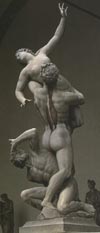
|
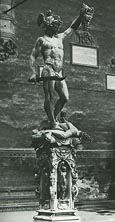
|
|
|
|
|
|
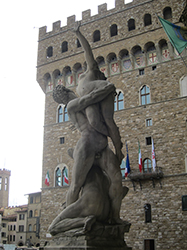 |
Hartt,p. 642: Although the identity of the subject mattered little to him, he [Giovanni Bologna] eventually decided on the Rape of the Sabine Woman as the title for his colossal marble group set in 1583 in the Loggia dei Lanzi, near Cellini's Perseus [and Medusa]. In contrast to all earlier statues, which concentrate on a principal view to which all others are subordinated, Bologna's composition sends us constantly around the group from one view to the next; as all the figures are engaged in the spiral movement, it is impossible to choose a principal view. The way arms and legs fly off into space was, of course, a violation of everything for which Michelangelo stood, but also a dazzling display of Bologna's skill in handling marble.

|
|
|
p. 651: Like so many of the artist's [Titian's] later works, the Rape of Europa was probably painted off and on during several years, in this case about 1559-62. The white bull, one of the many disguises of Jupiter, carries the distraught yet yielding Europa, in one of the most beautiful poses of Renaissance art, combining surprise, abandon, and unconscious grace, over a glittering blue-green and foam-flecked sea. Cupid floats on a dolphin, and a glittering golden fish surfaces below.
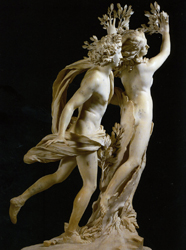
|
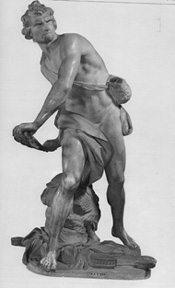
|
|
|
|
p. 699: An even more transient moment of climatic action, perception, and feeling is represented by the companion work for Cardinal Borghese, the Apollo and Daphne, started the year before the David and finished two years later. Bernini has seized on the second in which the panting god, in hot pursuit of the chaste Daphne (Ovid, Metamorphoses I :450-567), is foiled when she calls on her father, the river-god Peneus, for rescue and is transformed into a laurel tree. The toes of her left foot have already taken root, bark has shot up around her left leg and started to enclose her waist, her fingers and her hair are already turning into leaves and twigs, but the change is so sudden that the expression of terror has not yet left her face nor that of desire the Classical features of Apollo. The fidelity with which the softness of female flesh; the lithe body of Apollo; the textures of hair, bark, and leaves are rendered is no more dazzling than Bernini's craftsmanship in carving the scores of minute and slender projections from fragile marble. He has reached in his mid-twenties the height of his ability at pictorial sculpture -- the negation of everything Michelangelo stood for.... Evanescent effects of melting texture, translucency, and sparkle so dissolve the group into the surrounding space that it is as if Bernini had been able to carve light and air as well as marble.
[Cardinal Borghese also commissioned Bernini to do an image of Pluto and Persephone to be a companion to the David, and Apollo and Daphne:
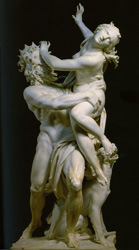
|
|
|
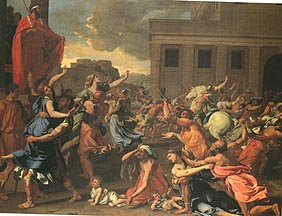
|
|
|
p. 713: At another point Poussin expounded his theory of the modes of painting by analogy with the modes or scales in Greek music, and mentioned five, the Dorian, the Phrygian, the Lydian, the Hypolydian, and the Ionic. He really did carry his ideas of the modes systematically into execution. His Rape of the Sabines [Fig. 6], of about 1636-37, exemplifies the Phrygian mode adapted to "frightful wars"; nonetheless, its "modulations are more subtle than other modes," Plato and Aristotle "held in high esteem this vehement, furious, and highly severe Mode, that astonishes the spectator." The subject is lofty, for the abduction of the Sabine women by the bachelor Romans assured the perpetuation of the Roman race; the conception is powerful; the composition effortless and natural for all its references to ancient and Renaissance statuary figures and groups; and the style beyond all praise.... The composition is staged in a limited space, flanked on one side by the temple portico in which Romulus stands and limited at the rear by a structure whose appearance is reconstructed from Vitruvius's description of a basilica. The building in the landscape in the background recalls the hill fortress of Annibale Carracci's Landscape with the Flight into Egypt. The rhythm surges along with the driving energy of a fugue by Bach or Handel, every melody of torso or limb distinguishable and perfectly modeled. Although the result may seem artificial, accepted on Poussin's own intellectual premises the painting is brilliantly effective. And, perhaps in spite of Poussin, the grand sweep of forms and colors has an undefinable something that we can call Baroque.
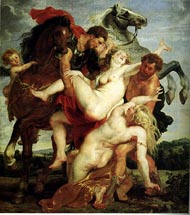
|
|
|
p. 723:[Rubens's] Rape of the Daughters of Leucippus [Fig. 7], of about 1616-17, recalls forcibly Titian's Rape of Europa, which Rubens carefully copied while in Spain. Although the figures have been made to fit into Rubens's mounting spiral, such is the buoyancy of the composition that the result does not seem artificial. The act of love by which Castor and Pollux, sons of Jupiter, uplift the mortal maidens from the ground draws the spectator upward in a mood of rapture not unrelated to that Bernini was soon to achieve in the Ecstasy of St. Theresa. The female types, even more abundant than those of Titian, are traversed by a steady stream of energy, and the material weight of all the figures is lightened by innumerable fluctuations of color running through their pearly skin, the tanned flesh of the men, the armor, the horses, even the floods of golden hair. The low horizon increases the effect of a heavenly ascension, natural enough, since this painting ... constitutes a triumph of divine love; the very landscape heaves and flows in response to the excitement of the event.